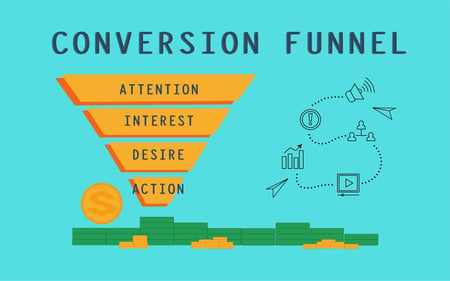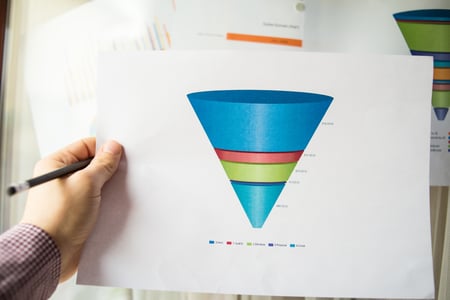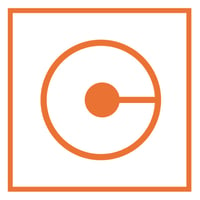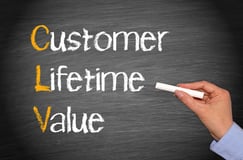Index Content
A sales funnel in marketing is defined as the methodology used to plan which steps a user takes before reaching their final goals.
The term sales funnel is also known as a sales funnel and is the way in which a company or business establishes methods of contacting different users to achieve an end goal. This goal can be anything from filling out a form, to getting a big sale, to getting many customers.
{% video_player "embed_player" overrideable=False, type='hsvideo2', hide_playlist=True, viral_sharing=False, embed_button=False, autoplay=False, hidden_controls=False, loop=False, muted=False, full_width=False, width='1920', height='1080', player_id='91729437241'', style='' %}how does a sales funnel work?
As its name suggests, a sales funnel works like a traditional funnel. That is, we have a very large amount of information about different users captured through different media and we want that information to be much more specific. To make a sales funnel we need to:
- Define the problem to be solved.
- Create an offer to generate leads.
- Confirm that all leads are interested in the good or service being offered.
- Nurture leads by offering demonstrations or trials.
- Close the deal with the leads and follow up on the results and sales data.

Tofu, mofu and bofu: the main funnel stages
The funnel is divided into three stages known as tofu, mofu and bofu. Here we show you what each one consists of and what content you should develop to attract the attention of consumers and, therefore, achieve more sales.
1.TOFU (TOP OF THE FUNNEL): During this first stage, the user detects that they have a need and begins to search for information on the internet to find a product or service that satisfies it. This first approach is what allows the brand to find out and investigate whether it can solve their problem. Therefore, during this phase it is advisable to spread the word:
-Blog articles, in which you can talk about the latest news or market trends.
-Publications on social networks that invite your followers to interact in order to generate engagement, such as Instagram, Facebook, Twitter, TikTok, LinkedIn...
-Tutorial videos, where you can show explanations on how to use your product.
2.MOFU (MIDDLE OF THE FUNNEL): The second stage consists of working to convert visits and followers into leads, i.e. prospects interested in making a purchase. To get this visit to become a lead, you have to provide them with specialised content in exchange for their contact details, such as their email address or telephone number, through a landing page. Some of the most attractive content to achieve this are:
-Ebooks that delve into the topic of interest of your target audience and are interesting for the reader.
-Webinars to educate leads and tell them about the benefits of hiring your services or purchasing your products.
-Interesting or eye-catchingevents that put prospects in context and feed their curiosity.
3.BOFU (BOTTOM OF THE FUNNEL): In the third and final stage of the sales funnel, the goal is to finally complete the conversion. It is a moment where the potential customer is considering buying and perhaps comparing your offer with those of your competitors. That is why it is of utmost importance to provide content that helps them make the decision to buy:
-Product demos or free trials for the user to evaluate whether it is what they are looking for. This is one of the most effective techniques as everyone is willing to get something for free, which they may or may not end up buying.
-Previous success stories so that future users can check that your service and product is effective.
-Discounts to encourage purchase.

Other stages in which the sales funnel is divided into
The funnel methodology is not only divided into the three stages depending on the part of the funnel the users are in, it can also be divided into five stages depending on how the customer is doing:
-Lead acquisition: In this stage, the most important thing is to get your future customers to give you their data so that you can use them in the sales funnel.
-Prospect: Once this happens, what you have are prospects, the previous leads are classified and segmented in order to create strategies according to them, so you save time and effort knowing in which part of your sales funnel each one of your leads is.
-Opportunity: In this phase you should focus on finding your sales opportunity, i.e. you already know what product or service the customer is most interested in and you should focus on showing them only what they consider relevant.
-Qualification: Measure and analyse the interactions that these future customers have had with the products, so you will know what specific interests they have and what will drive them to make a purchase.
-Closing: This is the last stage of the sales funnel, in this stage the lead has already become a customer, i.e. they have already made a sale, so the company has achieved its main objective.
Remember that if you build your sales funnel strategy well, you will manage to take your leads stage by stage until they become loyal customers.
{{cta('e03ded89-c98d-46eb-b25a-496d0f3ec890','justifycenter')}}




